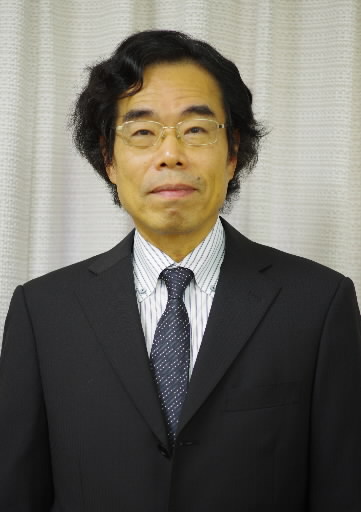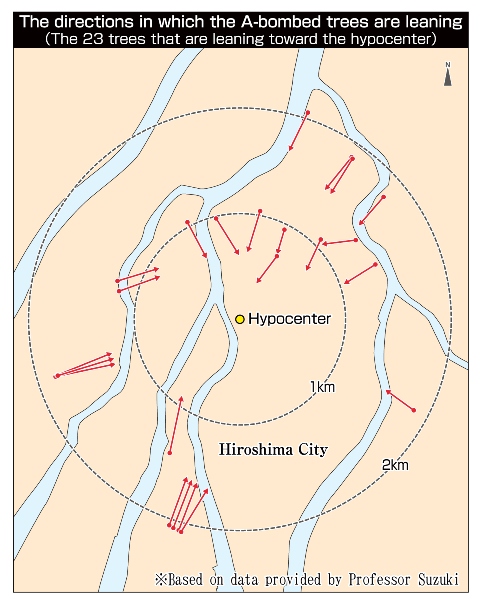Study finds that 80 percent of A-bombed trees with a single trunk lean toward the hypocenter
Oct. 24, 2013
by Sakiko Masuda, Staff Writer
Nearly 80 percent of A-bombed trees with a single trunk are leaning toward the hypocenter. This discovery was made in a study carried out by the University of Tsukuba and a tree doctor. The members of the research team conclude that this phenomenon is probably due to the fact that cells on the side of the trunk facing the hypocenter were damaged by the bomb’s heat rays and radiation, making this side grow more slowly than the other side.
The study was conducted by three experts: Masakazu Suzuki, 61, a professor of landscape architecture at the University of Tsukuba; Nagisa Owaki, 24, a second-year student at the University of Tsukuba’s Graduate School of Comprehensive Human Sciences; and Chikara Horiguchi, 68, a tree doctor and resident of Nishi Ward, Hiroshima.
In September, Professor Suzuki and his colleagues selected 56 A-bombed trees that have a single trunk, including camphor trees, ginkgo trees, and camellias, from among approximately 170 trees exposed to the A-bomb within about two kilometers of the hypocenter. Of these 56 trees, five had been burned to the ground, leaving behind only the portion below the soil, and 22 had been relocated after the atomic bombing. The remaining 29 trees were studied, and 79 percent, or 23 trees, were found to be tilting toward the hypocenter.
As for the angle of direction to which the trees are leaning toward the hypocenter, two are bent straight toward it, a zero-degree deviation from the direction of the hypocenter, and 16 trees are bent at angles of one to 15 degrees from this direction. The maximum angle is 29 degrees.
The experts speculate that the reason these trees are tilting in this direction is because the side facing the hypocenter grew more slowly due to the damage caused by the heat rays, radiation, and other factors. They say that the growth gap between the burned side and the other less-affected side has mounted over the years, causing the trees to gradually bend toward the hypocenter. The remaining six trees have not leaned toward the hypocenter, possibly because there were large fires on the other side of the trees or because the ground itself is uneven, they explained.
Professor Suzuki commented, “The A-bomb trees continue to point silently in the direction of the hypocenter, showing both their will to live and their lasting scars. We plan to proceed with our work, studying the background of each tree and its internal conditions.”
Results to be presented in Hiroshima on October 23
The results of the study will be presented at a public session held by the United Nations Institute for Training and Research (UNITAR) Hiroshima Office on October 23, from 6 p.m., in the East Building of Hiroshima Peace Memorial Museum.
A panel of four, including Nassrine Azimi, co-founder of the citizens’ group “Green Legacy Hiroshima”; Akio Nishikiori, an architect; and Professor Suzuki and Mr. Horiguchi, will discuss the significance of the A-bombed trees and related topics. The public session is free but requires prior registration. Call 082-511-2424 or send e-mail to hiroshima@unitar.org.
Keywords
A-bombed trees
“A-bombed trees” are those trees which have existed in Hiroshima since before the atomic bombing and were exposed to the bomb within about two kilometers from the hypocenter. The City of Hiroshima began a registry of A-bombed trees in 1996, based on people’s testimonies or verifications from a tree doctor, except for those trees located on private land that is closed to the general public. There are about 170 A-bombed trees of about 30 species, such as ginkgo trees, camellias, and Japanese hackberries, at 55 locations including parks and temples.
(Originally published on October 21, 2013)
Nearly 80 percent of A-bombed trees with a single trunk are leaning toward the hypocenter. This discovery was made in a study carried out by the University of Tsukuba and a tree doctor. The members of the research team conclude that this phenomenon is probably due to the fact that cells on the side of the trunk facing the hypocenter were damaged by the bomb’s heat rays and radiation, making this side grow more slowly than the other side.
The study was conducted by three experts: Masakazu Suzuki, 61, a professor of landscape architecture at the University of Tsukuba; Nagisa Owaki, 24, a second-year student at the University of Tsukuba’s Graduate School of Comprehensive Human Sciences; and Chikara Horiguchi, 68, a tree doctor and resident of Nishi Ward, Hiroshima.
In September, Professor Suzuki and his colleagues selected 56 A-bombed trees that have a single trunk, including camphor trees, ginkgo trees, and camellias, from among approximately 170 trees exposed to the A-bomb within about two kilometers of the hypocenter. Of these 56 trees, five had been burned to the ground, leaving behind only the portion below the soil, and 22 had been relocated after the atomic bombing. The remaining 29 trees were studied, and 79 percent, or 23 trees, were found to be tilting toward the hypocenter.
As for the angle of direction to which the trees are leaning toward the hypocenter, two are bent straight toward it, a zero-degree deviation from the direction of the hypocenter, and 16 trees are bent at angles of one to 15 degrees from this direction. The maximum angle is 29 degrees.
The experts speculate that the reason these trees are tilting in this direction is because the side facing the hypocenter grew more slowly due to the damage caused by the heat rays, radiation, and other factors. They say that the growth gap between the burned side and the other less-affected side has mounted over the years, causing the trees to gradually bend toward the hypocenter. The remaining six trees have not leaned toward the hypocenter, possibly because there were large fires on the other side of the trees or because the ground itself is uneven, they explained.
Professor Suzuki commented, “The A-bomb trees continue to point silently in the direction of the hypocenter, showing both their will to live and their lasting scars. We plan to proceed with our work, studying the background of each tree and its internal conditions.”
Results to be presented in Hiroshima on October 23
The results of the study will be presented at a public session held by the United Nations Institute for Training and Research (UNITAR) Hiroshima Office on October 23, from 6 p.m., in the East Building of Hiroshima Peace Memorial Museum.
A panel of four, including Nassrine Azimi, co-founder of the citizens’ group “Green Legacy Hiroshima”; Akio Nishikiori, an architect; and Professor Suzuki and Mr. Horiguchi, will discuss the significance of the A-bombed trees and related topics. The public session is free but requires prior registration. Call 082-511-2424 or send e-mail to hiroshima@unitar.org.
Keywords
A-bombed trees
“A-bombed trees” are those trees which have existed in Hiroshima since before the atomic bombing and were exposed to the bomb within about two kilometers from the hypocenter. The City of Hiroshima began a registry of A-bombed trees in 1996, based on people’s testimonies or verifications from a tree doctor, except for those trees located on private land that is closed to the general public. There are about 170 A-bombed trees of about 30 species, such as ginkgo trees, camellias, and Japanese hackberries, at 55 locations including parks and temples.
(Originally published on October 21, 2013)









